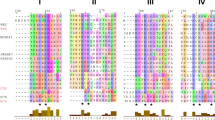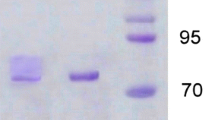Abstract
Laccases are blue multicopper oxidases that carry out single electron transfers in the oxidation of phenols to quinones. In plants, they confer structural stability to the cell wall. Thermostable laccases were identified in xerophytes Cereus pterogonus and Opuntia vulgaris that could be used in biotechnology and industrial processes. Polyclonal anti-laccase antibodies were generated against purified laccase enzyme isoforms capable of 98–99 % inhibition of the catalytic activity. Antibodies raised against lower molecular weight isoforms inhibited 70 % of the catalytic activity of higher molecular forms. Only 20 % inhibition was noted when assayed in reverse. A partial gene sequence of thermostable xerophytic laccase comprising 712 and 880 bp was identified employing cDNA as template. The nucleotide sequence was submitted to GenBank. The gene sequence was in silico translated into protein sequence and a 3-D structure was predicted using I-Tasser and Genesilico online servers that justified the experimental observations. Anti-laccase antibodies and nucleotide gene sequence of this thermostable plant laccase can be utilized for predicting laccase antigenic sequences and for cloning and expression of the thermostable eukaryotic laccase.






Similar content being viewed by others
References
Kumar, G. N., & Srikumar, K. (2011). Biomedical Chromatography, 25, 707–711.
Gali, N. K., & Kotteazeth, S. (2012). Chemistry of Natural Compounds, 48, 451–456.
Sharma, K. K., & Kuhad, R. C. (2008). Indian Journal of Microbiology, 48, 309–316.
Kumar, G. N., & Srikumar, K. (2012). Applied Biochemistry and Biotechnology, 167, 662–676.
Kumar, G. N., & Srikumar, K. (2013). Cellulose, 20, 115–125.
Tamminen, T., Keen, M., Ohra-Aho, T., & Poppius-Levin, K. (2003). Journal of Pulp and Paper Science, 29, 319–324.
Rodrilguez Couto, S., Sanromin, M., & Gulbitz, G. M. (2005). Chemosphere, 58, 417–422.
Edwards, W., Leukes, W. D., & Bezuidenhout, J. J. (2002). Desalination, 149, 275–278.
Duran, N., & Esposito, E. (2000). Applied Catalysis, B: Environmental, 28, 83–99.
Mustafa, R., Muniglia, L., Rovel, B., & Girardin, M. (2005). Food Research International, 38, 995–1000.
Jaouani, A., Guillein, F., Penninckx, M. J., Martinez, A. T., & Martinez, M. J. (2005). Enzyme and Microbial Technology, 36, 478–486.
Yaropolov, A. I., Skorobogatko, O. V., Vartanov, S. S., & Varfolomoyev, S. D. (1994). Applied Biochemistry and Biotechnology, 49, 257–280.
Golz, B., Walzel, B., Zastrow, L., Doucet, O. (2004). International Patent Application 2004–017931.
Selinheimo, E., Kruus, K., Buchert, J., Hopia, A., & Autio, K. (2006). Journal of Cereal Science, 43, 152–159.
Hoegger, P. J., Kilaru, S., James, T. Y., Thacker, J. R., & Kües, U. (2006). The FEBS Journal, 273, 2308–2326.
Feng, B., & Li, P. (2012). Genetica, 140, 477–484.
Kellner, H., Jehmlich, N., Benndorf, D., Hoffmann, R., Rühl, M., Hoegger, P. J., et al. (2007). Enzyme and Microbial Technology, 41, 694–701.
Towbin, H., Staehelin, T., & Gordon, J. (1979). Proceedings of the National Academy of Sciences of the United States of America, 76, 4350–4354.
Tel-Zur, N., Abbo, S., Myslabodski, D., & Mizrahi, Y. (1999). Plant Molecular Biology Reporter, 17, 249–254.
Chomczynski, P., & Sacchi, N. (1987). Analytical Biochemistry, 162, 156–159.
Xu, Y., Hong, Y., Xiao, Y., & Fang, W. (2007). Cellular & Molecular Immunology, 4, 315–317.
Ray, S., Chowdhury, P., Das, N., & Bishayi, B. (2012). Journal of Immunoassay and Immunochemistry, 31, 217–232.
Hoshida, H., Nakao, M., Kanazawa, H., Kubo, K., Hakukawa, T., Morimasa, K., et al. (2001). Journal of Bioscience and Bioengineering, 92, 372–380.
Téllez-Téllez, M., Diaz-Godinez, G., Aguilar, M. B., Sánchez, C., & Fernández, F. J. (2012). Biological Research, 7, 2038–2050.
Billette, C., Gibard, T., Foulongne-Oriol, M., Savoie, J. M. (2011). Proceedings of the 7th International Conference on Mushroom Biology and Mushroom Products (ICMBMP7) 212–223.
D’Souza, T. M., Boominathan, K., & Reddy, C. A. (1996). Applied and Environmental Microbiology, 62, 3739–3744.
Kim, J. K., Lim, S. H., & Kang, H. W. (2013). Mycobiology, 41, 37–41.
Komori, H., Miyazaki, K., & Higuchi, Y. (2009). FEBS Letters, 583, 1189–1195.
Polyakov, K. M., Fedorova, T. V., Kurzeev, S. A., Popov, A. N., Lamzin, V. S., Koroleva, O. V. (2011). http://www.rcsb.org/pdb/explore/explore.do?structureId=3PXL.
Ducros, V., Brzozowski, A. M., Wilson, K. S., Ostergaard, P., Schneider, P., Svendson, A., et al. (2011). Acta Crystallographica Section D, 57, 333.
Hakulinen, N., Andberg, M., Kallio, J., Koivula, A., Kruus, K., & Rouvinen, J. (2008). Journal of Structural Biology, 162, 29–39.
Acknowledgments
The authors wish to thank Mr. B. Ramachandra Mouli, Research Scholar, Molecular Medicine, Hannover Medical School, Hannover, Germany for the support rendered in generating polyclonal antibodies and Mr. K. Suresh, Research Scholar, AJOU University, Korea for timely suggestions in designing primers and in carrying out computational studies. Gali Nirmal Kumar wishes to thank University Grants Commission, New Delhi, India for the award of UGC Meritorious Research Fellowship in Science.
Author information
Authors and Affiliations
Corresponding author
Additional information
Ethical Considerations
The experiments with animal models were carried out carefully as per “Committee for the Purpose of Control and Supervision of Experiments on Animals” (CPCSEA 2003), New Delhi, India, guidelines and approved by Institutional Ethical Committee of Pondicherry University, Puducherry, India. The experimentation details were duly registered in animal house facility maintained at Pondicherry University, Puducherry, India. Animals were used to raise polyclonal antibodies, followed by careful drawing of blood, and at the end, animals were rehabilitated as per the guidelines.
Accession numbers in the GenBank database are as follows: JN793991, JN793990, 84618776, 30679958, 1621460, 3805959, and 13661206.
Electronic supplementary material
Below is the link to the electronic supplementary material.
ESM 1
(DOC 3207 kb)
Rights and permissions
About this article
Cite this article
Kumar, G.N., Srikumar, K. Molecular and Computational Approaches to Characterize Thermostable Laccase Gene from Two Xerophytic Plant Species. Appl Biochem Biotechnol 172, 1445–1459 (2014). https://doi.org/10.1007/s12010-013-0611-6
Received:
Accepted:
Published:
Issue Date:
DOI: https://doi.org/10.1007/s12010-013-0611-6




